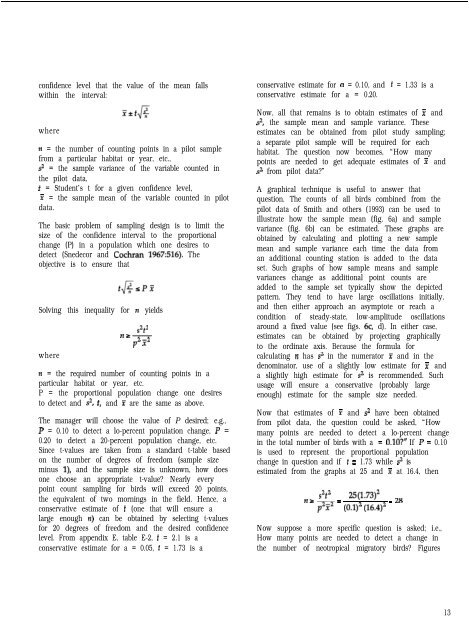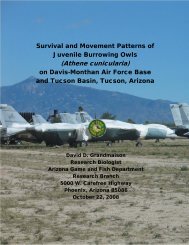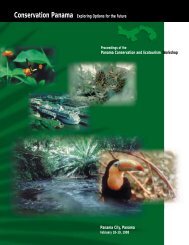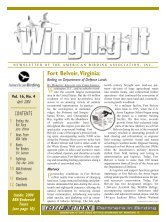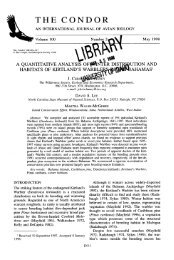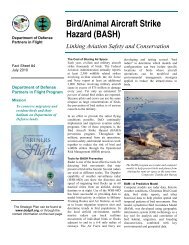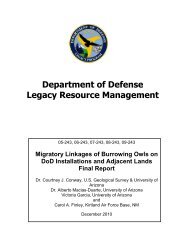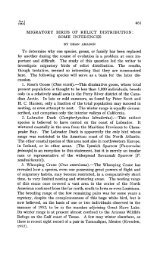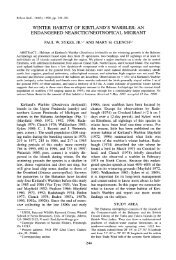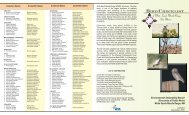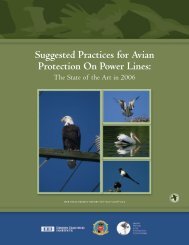A Land Manager's Guide to Point Counts of Birds in the Southeast
A Land Manager's Guide to Point Counts of Birds in the Southeast
A Land Manager's Guide to Point Counts of Birds in the Southeast
Create successful ePaper yourself
Turn your PDF publications into a flip-book with our unique Google optimized e-Paper software.
confidence level that <strong>the</strong> value <strong>of</strong> <strong>the</strong> mean falls conservative estimate for a = 0.10, and t = 1.33 is a<br />
with<strong>in</strong> <strong>the</strong> <strong>in</strong>terval: conservative estimate for a = 0.20.<br />
where<br />
n = <strong>the</strong> number <strong>of</strong> count<strong>in</strong>g po<strong>in</strong>ts <strong>in</strong> a pilot sample<br />
from a particular habitat or year, etc.,<br />
s2 = <strong>the</strong> sample variance <strong>of</strong> <strong>the</strong> variable counted <strong>in</strong><br />
<strong>the</strong> pilot data,<br />
t = Student’s t for a given confidence level,<br />
X = <strong>the</strong> sample mean <strong>of</strong> <strong>the</strong> variable counted <strong>in</strong> pilot<br />
data.<br />
The basic problem <strong>of</strong> sampl<strong>in</strong>g design is <strong>to</strong> limit <strong>the</strong><br />
size <strong>of</strong> <strong>the</strong> confidence <strong>in</strong>terval <strong>to</strong> <strong>the</strong> proportional<br />
change (P) <strong>in</strong> a population which one desires <strong>to</strong><br />
detect (Snedecor and Co&ran 1967:516). The<br />
objective is <strong>to</strong> ensure that<br />
Solv<strong>in</strong>g this <strong>in</strong>equality for n yields<br />
where<br />
s2t2<br />
?lLp2<br />
x2<br />
IZ = <strong>the</strong> required number <strong>of</strong> count<strong>in</strong>g po<strong>in</strong>ts <strong>in</strong> a<br />
particular habitat or year, etc.<br />
P = <strong>the</strong> proportional population change one desires<br />
<strong>to</strong> detect and s2, t, and X are <strong>the</strong> same as above.<br />
The manager will choose <strong>the</strong> value <strong>of</strong> P desired; e.g.,<br />
P = 0.10 <strong>to</strong> detect a lo-percent population change, P =<br />
0.20 <strong>to</strong> detect a 20-percent population change, etc.<br />
S<strong>in</strong>ce t-values are taken from a standard t-table based<br />
on <strong>the</strong> number <strong>of</strong> degrees <strong>of</strong> freedom (sample size<br />
m<strong>in</strong>us l), and <strong>the</strong> sample size is unknown, how does<br />
one choose an appropriate t-value? Nearly every<br />
po<strong>in</strong>t count sampl<strong>in</strong>g for birds will exceed 20 po<strong>in</strong>ts,<br />
<strong>the</strong> equivalent <strong>of</strong> two morn<strong>in</strong>gs <strong>in</strong> <strong>the</strong> field. Hence, a<br />
conservative estimate <strong>of</strong> t (one that will ensure a<br />
large enough n) can be obta<strong>in</strong>ed by select<strong>in</strong>g t-values<br />
for 20 degrees <strong>of</strong> freedom and <strong>the</strong> desired confidence<br />
level. From appendix E, table E-2, t = 2.1 is a<br />
conservative estimate for a = 0.05, t = 1.73 is a<br />
Now, all that rema<strong>in</strong>s is <strong>to</strong> obta<strong>in</strong> estimates <strong>of</strong> X and<br />
s2, <strong>the</strong> sample mean and sample variance. These<br />
estimates can be obta<strong>in</strong>ed from pilot study sampl<strong>in</strong>g;<br />
a separate pilot sample will be required for each<br />
habitat. The question now becomes, “How many<br />
po<strong>in</strong>ts are needed <strong>to</strong> get adequate estimates <strong>of</strong> Z and<br />
s2 from pilot data?”<br />
A graphical technique is useful <strong>to</strong> answer that<br />
question. The counts <strong>of</strong> all birds comb<strong>in</strong>ed from <strong>the</strong><br />
pilot data <strong>of</strong> Smith and o<strong>the</strong>rs (1993) can be used <strong>to</strong><br />
illustrate how <strong>the</strong> sample mean (fig. 6a) and sample<br />
variance (fig. 6b) can be estimated. These graphs are<br />
obta<strong>in</strong>ed by calculat<strong>in</strong>g and plott<strong>in</strong>g a new sample<br />
mean and sample variance each time <strong>the</strong> data from<br />
an additional count<strong>in</strong>g station is added <strong>to</strong> <strong>the</strong> data<br />
set. Such graphs <strong>of</strong> how sample means and sample<br />
variances change as additional po<strong>in</strong>t counts are<br />
added <strong>to</strong> <strong>the</strong> sample set typically show <strong>the</strong> depicted<br />
pattern. They tend <strong>to</strong> have large oscillations <strong>in</strong>itially,<br />
and <strong>the</strong>n ei<strong>the</strong>r approach an asymp<strong>to</strong>te or reach a<br />
condition <strong>of</strong> steady-state, low-amplitude oscillations<br />
around a fixed value (see figs. 6c, d). In ei<strong>the</strong>r case,<br />
estimates can be obta<strong>in</strong>ed by project<strong>in</strong>g graphically<br />
<strong>to</strong> <strong>the</strong> ord<strong>in</strong>ate axis. Because <strong>the</strong> formula for<br />
calculat<strong>in</strong>g n has s2 <strong>in</strong> <strong>the</strong> numera<strong>to</strong>r X and <strong>in</strong> <strong>the</strong><br />
denom<strong>in</strong>a<strong>to</strong>r, use <strong>of</strong> a slightly low estimate for !i and<br />
a slightly high estimate for s2 is recommended. Such<br />
usage will ensure a conservative (probably large<br />
enough) estimate for <strong>the</strong> sample size needed.<br />
Now that estimates <strong>of</strong> X and s2 have been obta<strong>in</strong>ed<br />
from pilot data, <strong>the</strong> question could be asked, “How<br />
many po<strong>in</strong>ts are needed <strong>to</strong> detect a lo-percent change<br />
<strong>in</strong> <strong>the</strong> <strong>to</strong>tal number <strong>of</strong> birds with a = O.lO?” If P = 0.10<br />
is used <strong>to</strong> represent <strong>the</strong> proportional population<br />
change <strong>in</strong> question and if t = 1.73 while s2 is<br />
estimated from <strong>the</strong> graphs at 25 and X at 16.4, <strong>the</strong>n<br />
s2t2 25(1.73)2<br />
” p2x2 = (0.g2 (16.4)2 - 28<br />
Now suppose a more specific question is asked; i.e.,<br />
How many po<strong>in</strong>ts are needed <strong>to</strong> detect a change <strong>in</strong><br />
<strong>the</strong> number <strong>of</strong> neotropical migra<strong>to</strong>ry birds? Figures<br />
13


